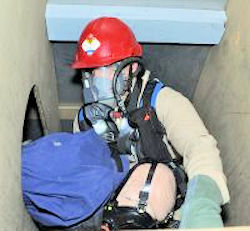Respiratory Protection
Respirators protect workers against insufficient oxygen environments (less than 19.5%), harmful dusts, fogs, smokes, mists, gases, vapors, and sprays.
These hazards may cause cancer, lung impairment, diseases, or death.
Respirators protect the user in two basic ways.
- The first is by the removal of contaminants from the air. Respirators of this type include particulate respirators, which filter out airborne particles, and air-purifying respirators with cartridges/canisters which filter out chemicals and gases.
- Other respirators protect by supplying clean respirable air from another source. Respirators that fall into this category include airline respirators, which use compressed air from a remote source, and self-contained breathing apparatus (SCBA), which include their own air supply.
Respiratory Protection
Respiratory protection is needed in confined spaces whenever:
- An emergency exists and entry cannot be delayed. Assume that an IDLH atmosphere exists.
- There is an inert atmosphere or testing shows that an IDLH exists and additional ventilation cannot reduce concentrations to safe levels.
- Current testing indicates atmosphere to be safe, but unsafe conditions could reasonably be expected to develop at any time.
Knowledge Check Choose the best answer for the question.
6-5. Respiratory protection in a confined space is necessary when _____.
You forgot to answer the question!

